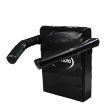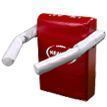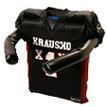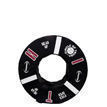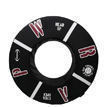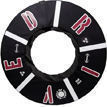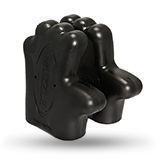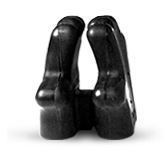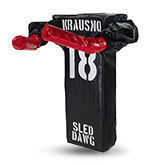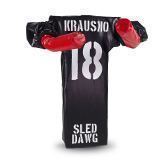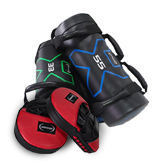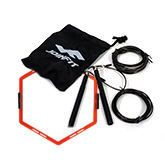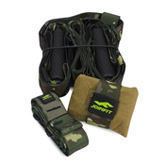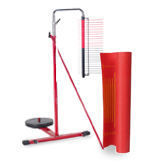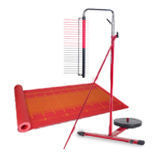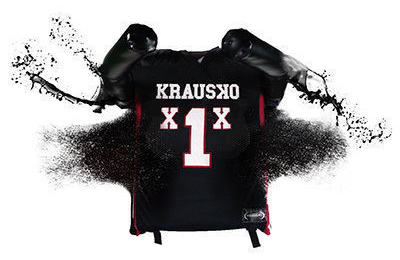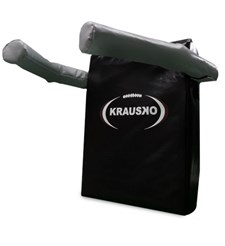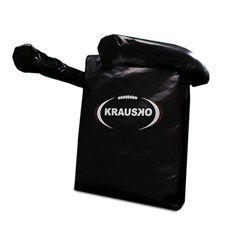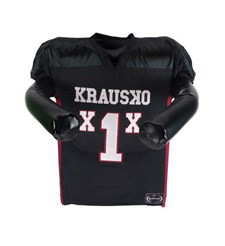Defensive Coach Pat Crowley
Defensive Line Coach Crowley Reviews the Colt
Colt Blocking Pad Teaches Players to Keep Pad Level Down
Q: How did you use the Colt in your progression with your defensive line?
A: We have a very set routine, and we incorporated the blocking pad after our footwork drills and stuff like that, but it was one of the main pieces of our stuff that we do every single day. The football blocking pad gave us more time in our individual period- which could be 15 to 20 minutes every single day- we got a chance to get a lot more reps for our DEs and DTs, and replicate full speed a lot more than I have in the past. It’s been 20 years of doing the same progression, so the blocking shield was a huge tool that we used and it helped us be much more efficient than in years past.
Q: What is the advantage of the Colt vs. a standard shield?
A: I never really use a lot of shield or dummies, I was always one of the coaches that wanted to get as close to the feeling of the shoulder pads and the arms and stuff like that. So, we did a lot of stuff that was one on one. I didn’t like using sleds, except maybe for a couple of them, because they’re static, they don’t move. They move when a player hits it, but it’s not a moving target.
Q: Are you able to control pad level with the Colt?
A: Absolutely. Like I alluded before, with a stationary blocking pad, it might be too high or too low, like a traditional sled. The Colt allows the coach or the player that’s holding it to keep pad level down. Pad level is one of the biggest things as far as defensive line play. Low man always wins. We’re constantly on our defensive lineman not to stand up. We want to keep them, at least their head, below the head of the offensive lineman. The way the Colt is built with the logo being the target for their eyes, and also with the arm placement it gave us that natural separation and for us to get our hands inside on the breast plate, or in that target area. So the blocking shield was very effective in adjusting pad level throughout the entire progression. We start out in a 6-point stance, and we move up to a 2-point stance out of a 4-point stance so we progress up through that blocking pad. We use every piece of it to keep pad level low where we need it to be.
Q: Are you able to control the degree of aggression with the Colt pad?
A: I don’t think you can ever be too violent as far as talking about offensive and defensive line play. What the Colt allowed us to do is rep at full speed. The blocking pad also allowed us to make sure our players stayed in position. We do a lot of stuff that’s half the man, whether they’re a 1-technique or a 2 or a 3, we’re always in some type of shade traditionally. What the football blocking pad allowed us to do is maintain that shade, but also the violence of which to stay in that position. Offensive lineman are moving and shuffling all the time, defensive lineman have to work an edge because they’re generally in a 2-on-1 situation. Two offensive lineman against 1 defensive lineman, especially now with zone blocking and chip blocking and things of that nature. We have to maintain an edge- pad level, and maintain separation. The arms on the blocking pad allow us to have that natural separation, but also allow us in our striking- with either a rip or a snake or whatever move we’re executing, or a shed move as far as run blocking goes- it allowed us to maintain that level of intensity throughout. We were also very thin, so we could not risk a player getting hurt or nicked up in a simple drill. This allowed us to go rep full speed and the blocking shield was used effectively, I’m very pleased with it.
Q: Are there other positions that you see the Colt being used as a tool?
A: Yeah, I think wide receivers are fantastic for their release moves and stuff like that. Running backs for their targets, linebackers (LBs) I see it as the old traditional way- linebacker play was read, step, follow, and blow it up in the hole. Now, it’s getting to the point where there’s not a lot of fullbacks anymore in offenses, so this is a great tool for linebackers because they don’t really know who’s going to be blocking them. The old traditional way would be the fullback or a tight end coming at them off a block. Now they have 16,000 different formations and no one really knows who is going to be blocking who. Linebacker play has now gotten to point where it’s more avoiding and getting to the area of where the ball is going to be, instead of the old I-formation, power, blow it up in the hole type of thing. It’s going away from that, so it’s nice for linebackers to use the blocking shield as their flow and as targets. To pick a target on the blocking pad, you know, I want to get on the outside arm to cut off for an angle. Or I need to get on the inside of the arm because we are going to try to take this on in the hole, so it’s great for linebackers. Obviously, offensive lineman I think it's a fantastic tool for. Coach Hubba alluded to that before. I also think, from my perspective, I like it for receivers as far as actually putting the Colt on a receiver as he’s going through his progression for catching. Instead of using a live body trying to swipe at the ball, you have a football shield. Anytime we can avoid injury and teach technique properly, we’ve found a great tool. One of the biggest factors in kids progressing through any type of activity- be it reading, writing or arithmetic, football, basketball or whatever, the risk of injury- if it’s there- is going to hinder their educational process. This allows us to practice, at full speed, muscle memory and everything else. It’s a great tool to use.
Q: What is the application in basketball?
A: Personally, I’m not much of a basketball coach, but I was in physical education for several years so I did teach basketball. As far as basketball goes, I know I would use the blocking shield in the low post, as far as post position and things of that nature. As a guard off the ball, it’s fantastic for getting through ball screens and stuff like that. We’ve actually had several basketball coaches use it. It allows players to rep at full speed. It’s not live. Live is live, there’s nothing you can do about that. This blocking shield allows you to get as close to live as possible, without injury, and I think that’s the most important thing. As a defensive line coach, the thing I like the most about the blocking shield with arms is the absolute violence that we can create with it. With the spring arms, they actually come back up into a stationary position or the original position they were in. Offensive lineman are always trying to get back into their area, we’re trying to attack them as fast as possible.
Q: How are the Colt arms different than traditional, flimsy Velcro arms?
A: It’s not a traditional blocking pad, from the standpoint of a traditional sled or a hand shield. Because of the arms and the natural spacing with the arms, that’s the best part I feel about it because defensive lineman traditionally have a hard time breaking away from going to a side, they’re always going to the middle. It’s like a moth to a flame. Once you can teach a kid to get on the edge of an offensive lineman, it makes their job and my job a lot easier. So, the pad is movable, it’s fluid. I am able to adjust either myself or with a player to adjust and put the pad on an edge, which creates a counter move for the player to get back to the other side- if it’s a run-shed drill that we’re doing- or especially in pass blocking or pass rush. We want those guys to work that edge. I can use that pad and they can maintain their pad level and they can also maintain their violence, which as you’re going through a pass rush situation every kid has a particular move that they use. They need to have another counter move or to come back with something else. This allows me, or another player while I’m watching, to maintain their pad level, but also work combinations and get off of a pass block as fast as possible. That’s where I see the biggest asset because the blocking pad moves, it moves anywhere I want on a body. Compared to just a shield and just body somebody up with it.
Q: As somebody is coming off the line, are they able to simulate the play accurately with the Colt?
A: The traditional way they used to teach pass blocking was one-on-one, two-on-two, things of that nature. I've never been a big proponent for one-on-one pass blocking because it’s not realistic. A defensive lineman is going to either get picked up by somebody else, either by another guard or a center or if they’re playing tackle it could be a running back coming over to chip and maybe going out into a formation or a pattern. So, our usage of the blocking pad is we have a series with two Colts 5 yards apart, one on the line of scrimmage and one 5 yards behind. We can rep pass rush at 100 miles per hour, or full speed, and maintain that player’s pad level all the way through, because they are going to get picked up. They never really get a one-on-one move with anybody because of the way protection schemes are set up now. What the blocking pad allows us to do is get off on the first guy, make sure you can get past him, use your moves to do it, maintain your pad level, now you’ve got somebody else to pick up. You can either completely avoid it with a swipe move, or a head fake, or something like that. Or even using it for your spin move. The biggest problem defensive lineman have with spinning is they don’t get penetration. On a traditional pad if you’re trying to teach them spin, or even on a live human body, what you can do with the Colt is you can actually put the player in a position. A position where they’re not comfortable to a position where they are comfortable. That’s the biggest advantage that we’ve found this year. Not going against live bodies but going against the pad at full speed the entire time.
Q: Do the arms on the Colt move? (Are you striking?)
A: Absolutely, you can strike the blocking pad as hard as you want because there’s no risk of injury. Traditionally when we would teach any type of move: a shed move or a pass rush move, you’re going on a body and you’re going against your partner. Well, the biggest problem with going against your partner is- he doesn’t want to get hurt and the other guy doesn’t really want to get hurt either. With this football blocking pad, it allows us to put them in the position we need them to be in, but also be able to get violent and strike it. The arms are going to come back into the same position. It allows you to do different moves, different combinations of moves, without the risk of injury. I use the blocking pad for the traditional club move, rip, snake, etc. This pad allows you to counter. I can come in with a club, and either come up with a rip or come over with something like a snake. If I have to get to the other side of the body because let’s say the offensive lineman has an outside set and the inside area is open, the blocking pad allows you come through and rip underneath and also move the arms out of the way.
